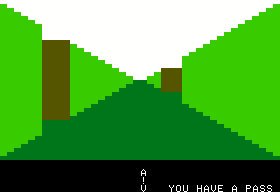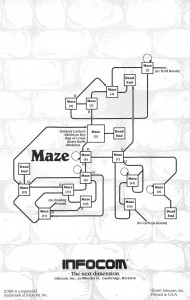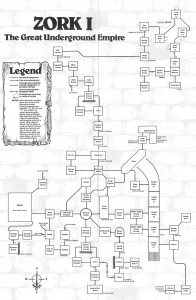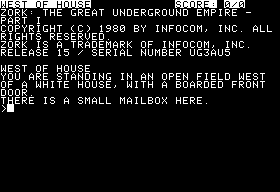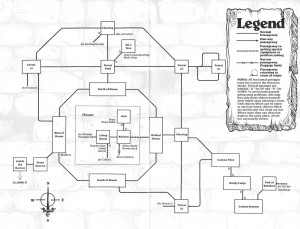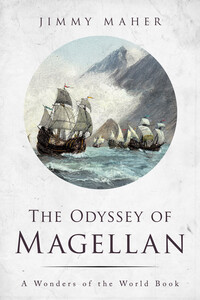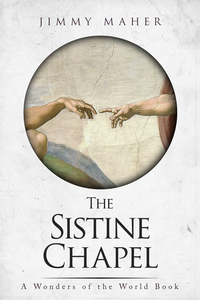Ever stumbled across something you’ve been looking for for a long time while you’re doing something else entirely? Well, I’ve just found the digital equivalent of my cat’s favorite toy which I found last week while reaching under the television stand to try to reset our infernal TV box. I’ve found the game Escape!, the Apple II maze game that inspired Richard Garriott to program the 3D dungeons of Akalabeth. Turns out it was written by Silas Warner of Muse Software, about whom I’ll have much more to say shortly. In the meantime, I’ve updated the old post on Garriott to reflect my discovery. Or, if you’d like to cut to the chase, here’s a screenshot and a disk image for ya. Type “RUN ESCAPE” after booting the disk to get started.
Author Archives: Jimmy Maher
Exploring Zork, Part 3
Today we’ll finish up with Zork. That means plunging into the only big, completely traditional maze in the Infocom canon. And it’s a nasty one; apparently they decided that if you’re only going to do one, you might as well do it up right.
In keeping with the thief’s role as a stand-in for Adventure‘s pirate, the maze is where he has his lair. This fact, even more than its sheer size, is the root of its difficulty: as you wander about inside dropping items and mapping, chances are good that the thief will show up to scatter your carefully placed items about and leave you hopelessly confused. Like the combat sequences, success here requires luck and careful saving and restoring more than skill. Nowhere else does Zork so thoroughly justify Robb Sherwin’s statement that it “hates its player.”
Within the maze is the “CYCLOPS ROOM.”
>SE
CYCLOPS ROOM
THIS ROOM HAS AN EXIT ON THE NORTHWEST,
AND A STAIRCASE LEADING UP.
A CYCLOPS, WHO LOOKS PREPARED TO EAT
HORSES (MUCH LESS MERE ADVENTURERS),
BLOCKS THE STAIRCASE. FROM HIS STATE OF
HEALTH, AND THE BLOODSTAINS ON THE
WALLS, YOU GATHER THAT HE IS NOT VERY
FRIENDLY, THOUGH HE LIKES PEOPLE.
There are two possible solutions to the cyclops problem, one basically acceptable and one easily the worst in the game. For the former, we can give him the lunch we found in the house at the beginning of the game, followed by the bottle of water. The latter is another guess-the-word affair that makes the loud room look like design genius: we can type “ODYSSEUS.”
>ODYSSEUS
THE CYCLOPS, HEARING THE NAME OF HIS
FATHER'S DEADLY NEMESIS, FLEES THE ROOM
BY KNOCKING DOWN THE WALL ON THE EAST OF
THE ROOM.
But never fear, there is a “clue” to this solution. Reading a prayer book we found in the temple yields the following:
>EXAMINE BOOK
COMMANDMENT #12592
OH YE WHO GO ABOUT SAYING UNTO EACH:
“HELLO SAILOR”:
DOST THOU KNOW THE MAGNITUDE OF THY SIN
BEFORE THE GODS?
YEA, VERILY, THOU SHALT BE GROUND
BETWEEN TWO STONES.
SHALL THE ANGRY GODS CAST THY BODY INTO
THE WHIRLPOOL?
SURELY, THY EYE SHALL BE PUT OUT WITH A
SHARP STICK!
EVEN UNTO THE ENDS OF THE EARTH SHALT
THOU WANDER AND
UNTO THE LAND OF THE DEAD SHALT THOU BE
SENT AT LAST.
SURELY THOU SHALT REPENT OF THY CUNNING.
On the original PDP-10 implementation, reading the first letter of each line yields “ODYSSEUS.” On the 40-column Apple II screen, however, this rather breaks down. It’s an awful “puzzle,” but the fact that Infocom give the player a more reasonable alternative really marks them, for all their continuing design pratfalls, as unusual text-adventure developers for this era. Scott Adams or Roberta Williams would have just stuck the easy-to-implement “ODYSSEUS” puzzle in and dreamed of all the hint booklets they were about to sell.
Beyond the cyclops lies the thief’s lair. Giving him his reckoning feels sweet indeed after all the trouble he’s caused us, not to mention restoring to us whatever treasures he’s stolen.
>U
YOU HEAR A SCREAM OF ANGUISH AS YOU
VIOLATE THE ROBBER'S HIDEAWAY. USING
PASSAGES UNKNOWN TO YOU, HE RUSHES TO
ITS DEFENSE.
THE THIEF GESTURES MYSTERIOUSLY, AND THE
TREASURES IN THE ROOM SUDDENLY VANISH.
TREASURE ROOM
THIS IS A LARGE ROOM, WHOSE EAST WALL IS
SOLID GRANITE. A NUMBER OF DISCARDED
BAGS, WHICH CRUMBLE AT YOUR TOUCH, ARE
SCATTERED ABOUT ON THE FLOOR. THERE IS
AN EXIT DOWN A STAIRCASE.
THERE IS A SUSPICIOUS-LOOKING
INDIVIDUAL, HOLDING A BAG, LEANING
AGAINST ONE WALL. HE IS ARMED WITH A
VICIOUS-LOOKING STILETTO.
THERE IS A SILVER CHALICE, INTRICATELY
ENGRAVED, HERE.
THE THIEF RAMS THE HAFT OF HIS BLADE
INTO YOUR STOMACH, LEAVING YOU OUT OF
BREATH.
>KILL THIEF WITH AXE
YOU ARE STILL RECOVERING FROM THAT LAST
BLOW, SO YOUR ATTACK IS INEFFECTIVE.
YOU PARRY A LIGHTNING THRUST, AND THE
THIEF SALUTES YOU WITH A GRIM NOD.
>KILL THIEF WITH AXE
THE THIEF IS STRUCK ON THE ARM, BLOOD
BEGINS TO TRICKLE DOWN.
THE THIEF STABS NONCHALANTLY WITH HIS
STILETTO AND MISSES.
>AGAIN
THE BLOW LANDS, MAKING A SHALLOW GASH IN
THE THIEF'S ARM!
THE THIEF TRIES TO SNEAK PAST YOUR
GUARD, BUT YOU TWIST AWAY.
>AGAIN
THE BLOW LANDS, MAKING A SHALLOW GASH IN
THE THIEF'S ARM!
THE THIEF SLOWLY APPROACHES, STRIKES
LIKE A SNAKE, AND LEAVES YOU WOUNDED.
>AGAIN
THE THIEF IS STRUCK ON THE ARM, BLOOD
BEGINS TO TRICKLE DOWN.
THE THIEF STABS NONCHALANTLY WITH HIS
STILETTO AND MISSES.
>AGAIN
YOU CHARGE, BUT THE THIEF JUMPS NIMBLY
ASIDE.
THE THIEF STABS NONCHALANTLY WITH HIS
STILETTO AND MISSES.
>AGAIN
THE FATAL BLOW STRIKES THE THIEF SQUARE
IN THE HEART: HE DIES.
But wait… remember when I mentioned way back at the beginning of this adventure that the jeweled egg we found in the forest was key to the cruelest puzzle in the game? Well, I’m afraid we need to get the thief to do something for us before we kill him. We need to let him open the egg for us, for, as subtly hinted when we try to do it ourselves, we “HAVEN’T THE TOOLS OR EXPERTISE.”
With the maze explored and the thief employed and then promptly dispatched, we face only one last puzzle — but it’s another nasty one, a late addition that we could just as well have done without. From time to time while wandering in the forest, we “HEAR IN THE DISTANCE THE CHIRPING OF A SONG BIRD,” a message originally included as just a bit of flavor text. Tim Anderson:
Many people on the net had long since solved the game, but went back in and did any new problems that came along; one of them had played DD with Dave, and called him up about a day after the egg was announced. "I've gotten the egg opened, but I assume you losers have some nonsense where you do something with the canary and the songbird. Dave, no fool, said "Cough, cough, ahem, of course," and immediately went off and added the brass bauble.
Specifically, we need to wind the clockwork canary we found inside the egg to attract the songbird, which in turn drops a brass bauble at our feet — the 19th and final treasure. We place the lot in the trophy case, which magically opens up a new path outside.
>SW
STONE BARROW
YOU ARE STANDING IN FRONT OF A MASSIVE
BARROW OF STONE. IN THE EAST FACE IS A
HUGE STONE DOOR WHICH IS OPEN. YOU
CANNOT SEE INTO THE DARK OF THE TOMB.
>W
AS YOU ENTER THE BARROW, THE DOOR CLOSES
INEXORABLY BEHIND YOU. AROUND YOU IT IS
DARK, BUT AHEAD IS AN ENORMOUS CAVERN,
BRIGHTLY LIT. THROUGH ITS CENTER RUNS A
WIDE STREAM. SPANNING THE STREAM IS A
SMALL WOODEN FOOTBRIDGE, AND BEYOND A
PATH LEADS INTO A DARK TUNNEL. ABOVE THE
BRIDGE, FLOATING IN THE AIR, IS A LARGE
SIGN. IT READS: ALL YE WHO STAND BEFORE
THIS BRIDGE HAVE COMPLETED A GREAT AND
PERILOUS ADVENTURE WHICH HAS TESTED YOUR
WIT AND COURAGE. YOU HAVE GAINED THE
MASTERY OF THE FIRST PART OF THE GREAT
UNDERGROUND EMPIRE. THOSE WHO PASS OVER
THIS BRIDGE MUST BE PREPARED TO
UNDERTAKE AN EVEN GREATER ADVENTURE THAT
WILL SEVERELY TEST YOUR SKILL AND
BRAVERY!
PLAY "ZORK: THE GREAT UNDERGROUND
EMPIRE, PART II".
YOUR SCORE WOULD BE 350 (TOTAL OF 350
POINTS), IN 1313 MOVES.
THIS SCORE GIVES YOU THE RANK OF MASTER
ADVENTURER.
And that, my friends, is Zork, a flawed creation but a tremendous advance over what had come before. And Infocom were just getting started.
I’ll have much, much more to say about Infocom in the future. But next, something completely different.
Exploring Zork, Part 2
Today we’ll tackle the meat of Zork‘s Great Underground Empire, shown on the map below.
Exploring south from the cellar where we left off yields our second treasure and our first way out of the underground; we can carry exactly two items out with us via the fireplace in the living room of the white house. (But we can’t go back down that way; “ONLY SANTA CLAUS CLIMBS DOWN CHIMNEYS,” the game tells us, in a classic bit of adventure-game logic.) As we explore we’ll continue to find more and more — and more and more convenient — means of ingress and egress. Eventually, even the unknown nasty who keeps closing and barring the trapdoor behind us will stop it.
We also find a second note — oops, an “OWNER’s MANUAL” — south of the cellar. It conveys some of the wonder of this little, functioning world Infocom have constructed.
>EXAMINE PAPER
CONGRATULATIONS!
YOU ARE THE PRIVILEGED OWNER OF A
GENUINE ZORK GREAT UNDERGROUND EMPIRE
(PART I), A SELF CONTAINED AND SELF
MAINTAINING UNIVERSE. IF USED AND
MAINTAINED IN ACCORDANCE WITH NORMAL
OPERATING PRACTICES FOR SMALL UNIVERSES,
ZORK WILL PROVIDE MANY MONTHS OF
TROUBLE-FREE OPERATION. PLEASE CHECK
WITH YOUR DEALER FOR PART II AND OTHER
ALTERNATE UNIVERSES.
Like the title page shown in my previous post, the note also shows that Infocom were also already planning at least a Zork 2 at this stage, even if their naming rubric could still use some work. More interestingly, it also shows that they were already envisioning parlaying ZIL and the Z-Machine into a whole line of other, original games. In including an advertisement for other games within this one, Infocom were following the lead of Scott Adams, who always seemed to find space to plug one or two other current or upcoming games even within his tiny 16 K creations.
When we proceed north from the cellar, we run into a sort of perfect storm of bad luck.
>N
THE TROLL ROOM
THIS IS A SMALL ROOM WITH PASSAGES TO
THE EAST AND SOUTH AND A FORBIDDING HOLE
LEADING WEST. BLOODSTAINS AND DEEP
SCRATCHES (PERHAPS MADE BY AN AXE) MAR
THE WALLS.
A NASTY-LOOKING TROLL, BRANDISHING A
BLOODY AXE, BLOCKS ALL PASSAGES OUT OF
THE ROOM.
A SEEDY-LOOKING INDIVIDUAL WITH A LARGE
BAG JUST WANDERED THROUGH THE ROOM. ON
THE WAY THROUGH, HE QUIETLY ABSTRACTED
ALL VALUABLES FROM THE ROOM AND FROM
YOUR POSSESSION, MUMBLING SOMETHING
ABOUT "DOING UNTO OTHERS BEFORE.."
THE TROLL'S MIGHTY BLOW DROPS YOU TO
YOUR KNEES.
THE THIEF SLOWLY APPROACHES, STRIKES
LIKE A SNAKE, AND LEAVES YOU WOUNDED.
>KILL TROLL WITH SWORD
I CAN'T SEE ANY SWORD HERE.
>KILL TROLL WITH KNIFE
A GOOD STROKE, BUT IT'S TOO SLOW, THE
TROLL DODGES.
THE TROLL'S AXE REMOVES YOUR HEAD.
IT APPEARS THAT THAT LAST BLOW WAS TOO
MUCH FOR YOU. I'M AFRAID YOU ARE DEAD.
**** YOU HAVE DIED ****
What’s happened here is that we’ve simultaneously met two of the other inhabitants of the underground, the troll and the thief. The former stays in place, but the latter is Zork‘s response to the pirate and the dwarfs of Adventure, a classic Dungeons and Dragons-style “wandering monster.” He roams throughout the underground, and not only takes the occasional poke at us with his stiletto, but — worse — picks up items we might have left here or there for safekeeping and scatters them randomly about. Even worse, he takes treasures for himself, hiding them away (more on that later). And worst of all, he’s happy to steal things off our own person. Woe to the adventurer whom he leaves in the dark without a lamp! In this case, he steals our sword just as we kind of need it to fight him and the troll and all, leaving us with only the much less effective knife. The end result is predictable.
The credit (or blame) for the combat engine belongs to Lebling:
Dave, an old Dungeons and Dragons player, didn’t like the completely predictable ways of killing creatures off. In the original game, for example, one killed a troll by throwing a knife at him; he would catch the knife and gleefully eat it (like anything else you threw at him), but hemorrhage as a result. Dave added basically the full complexity of DD-style fighting, with different strengths for different weapons, wounds, unconsciousness, and death. Each creature had its own set of messages, so a fight with the thief (who uses a stiletto) would be very different from a fight with the troll and his axe.
The danger of all this dynamism and emergent behavior is that it can lead to exactly the sort of thing that just happened to us, where the player is killed capriciously, without ever really having a chance. Eamon players never seemed to mind that sort of thing, but it didn’t sit well with Infocom. They would back well away from randomized combat in later games, a bias that the modern interactive fiction community has generally taken to heart. The main sign of this road not taken in the later Infocom canon is the “DIAGNOSE” verb, introduced in Zork to give the player a quick rundown of her current wounds, which persisted in later games as a rather pointless oddity generally yielding a generic response. Notably, “DIAGNOSE” is the only standard verb of the Infocom system that was not adapted by more modern IF languages like Inform and TADS.
Anyway, we restore a time or two, get a bit more lucky with our die rolls, kill the troll and avoid the thief, and move on into the reservoir area and, eventually, Flood Control Dam #3, one of the more memorable Zork landmarks. The relatively sober descriptions of the grand, long abandoned edifice itself are contrasted with the silliness of the guidebook we find inside the lobby.
>EXAMINE GUIDEBOOK
"FLOOD CONTROL DAM #3
FCD#3 WAS CONSTRUCTED IN YEAR 783 OF
THE GREAT UNDERGROUND EMPIRE TO HARNESS
THE MIGHTY FRIGID RIVER. THIS WORK WAS
SUPPORTED BY A GRANT OF 37 MILLION
ZORKMIDS FROM YOUR OMNIPOTENT LOCAL
TYRANT LORD DIMWIT FLATHEAD THE
EXCESSIVE. THIS IMPRESSIVE STRUCTURE IS
COMPOSED OF 370,000 CUBIC FEET OF
CONCRETE, IS 256 FEET TALL AT THE
CENTER, AND 193 FEET WIDE AT THE TOP.
THE LAKE CREATED BEHIND THE DAM HAS A
VOLUME OF 1.7 BILLION CUBIC FEET, AN
AREA OF 12 MILLION SQUARE FEET, AND A
SHORE LINE OF 36 THOUSAND FEET.
WE WILL NOW POINT OUT SOME OF THE MORE
INTERESTING FEATURES OF FCD#3 AS WE
CONDUCT YOU ON A GUIDED TOUR OF THE
FACILITIES:
1) YOU START YOUR TOUR HERE IN
THE DAM LOBBY. YOU WILL NOTICE ON
YOUR RIGHT THAT .........
Much of Zork‘s literary character, which comes through quite distinctly despite the relatively limited number of actual words in the game (it’s mostly been the very longest descriptions that I’ve been quoting here), arises from this juxtaposition of melancholic, faded glory and unabashed silliness. I’ll let you decide whether that was a real aesthetic choice or the accidental result of having too many cooks (writers) in the kitchen. In any case, we find another prime example of said silliness in the dam’s maintenance room.
>N
MAINTENANCE ROOM
THIS IS WHAT APPEARS TO HAVE BEEN THE
MAINTENANCE ROOM FOR FLOOD CONTROL DAM
#3. APPARENTLY, THIS ROOM HAS BEEN
RANSACKED RECENTLY, FOR MOST OF THE
VALUABLE EQUIPMENT IS GONE. ON THE WALL
IN FRONT OF YOU IS A GROUP OF BUTTONS,
WHICH ARE LABELLED IN EBCDIC. HOWEVER,
THEY ARE OF DIFFERENT COLORS: BLUE,
YELLOW, BROWN, AND RED. THE DOORS TO
THIS ROOM ARE IN THE WEST AND SOUTH
ENDS.
THERE IS A GROUP OF TOOL CHESTS HERE.
THERE IS A WRENCH HERE.
THERE IS AN OBJECT WHICH LOOKS LIKE A
TUBE OF TOOTHPASTE HERE.
THERE IS A SCREWDRIVER HERE.
The “EBCDIC” reference is a bit of hacker humor that might, depending on your background, require some explanation. During the early 1960s most computer makers agreed on something called ASCII (“American Standard Code for Information Interchange”) as a system for encoding textual characters on computers. Since computers can ultimately understand only numbers, ASCII is essentially a look-up table that the computer can use to know that when it encounters, say, the number 65 in a text file, it should print the character “A” to the screen. A standard was necessary to ensure that computers of different makes and models could easily exchange textual information amongst themselves. Just as everyone had settled on ASCII and thus solved a rather vexing problem, however, IBM suddenly chose to abandon the standard on its mainframes in favor of something called EBCDIC (“Extended Binary-Coded Decimal Interchange Code”). Its reason for doing so, at least according to DEC hackers, was a deliberate effort to make its machines incapable of exchanging data with those from other manufacturers, in the belief that doing so would lock its customers into using only IBM products for absolutely everything. To make things worse, EBCDIC was just a bad system in comparison to ASCII. In ASCII “A” numerically precedes “B” which precedes “C,” etc.; in EBCDIC each letter is assigned a number willy-nilly, with no apparent rhyme or reason. This makes, say, looping through the alphabet, a scenario that comes up quite often in programming, much more difficult than it ought to be. And then there was IBM’s habit of constantly revising EBCDIC, making it even incompatible with itself in its various versions. Still, it persists even today on the big legacy mainframes. Among hackers, EBCDIC came to stand in for any incomprehensible bit of language or jibberish, the hacker equivalent of saying (with apologies to anyone who actually speaks Greek), “It’s Greek to me!” And that, to make a long explanation not much longer, is the reason that the dam’s buttons are labelled in EBCDIC.
We solve a clever puzzle at the dam to adjust the water level on its two sides, thus opening up the river and the northern part of the underground for exploration. Before we do that, though, we’ll have a look at the temple to the southeast. We find there an ivory torch that, in addition to being a treasure, functions as an inexhaustable light source. This bit of mercy is even more appreciated than the extra batteries we can find in Adventure, particularly since using it doesn’t cost us points. We just need to be sure we conserve enough lantern-life to get us through the coal mine, about which more in a moment.
The sceptre, a treasure we find under the temple in the “EGYPTIAN ROOM,” is at the heart of the first really bad puzzle of the game. We are expected to take it to the rainbow outside and wave it to cross and reveal the inevitable pot of gold.
>WAVE SCEPTRE
SUDDENLY, THE RAINBOW APPEARS TO BECOME
SOLID AND, I VENTURE, WALKABLE (I THINK
THE GIVEAWAY WAS THE STAIRS AND
BANNISTER).
>E
ON THE RAINBOW
YOU ARE ON TOP OF A RAINBOW (I BET YOU
NEVER THOUGHT YOU WOULD WALK ON A
RAINBOW), WITH A MAGNIFICENT VIEW OF THE
FALLS. THE RAINBOW TRAVELS EAST-WEST
HERE.
If you’ve played a few adventure games, of course, you fully expected to walk on that rainbow. The question is how you’re supposed to arrive at this particular way of doing it. The one real hint is external to the game: Adventure featured a rod that it was possible to wave to cross a similar (albeit rainbow-less) chasm. Thus we have yet another point where Zork simply seems to assume previous knowledge of Adventure — although even given that knowledge solving this puzzle requires quite an intuitive leap.
After exploring the region beyond the rainbow, we return underground and eventually wind up in… Hades.
>D
ENTRANCE TO HADES
YOU ARE OUTSIDE A LARGE GATEWAY, ON
WHICH IS INSCRIBED
"ABANDON EVERY HOPE, ALL YE WHO
ENTER HERE."
THE GATE IS OPEN; THROUGH IT YOU CAN SEE
A DESOLATION, WITH A PILE OF MANGLED
BODIES IN ONE CORNER. THOUSANDS OF
VOICES, LAMENTING SOME HIDEOUS FATE, CAN
BE HEARD.
THE WAY THROUGH THE GATE IS BARRED BY
EVIL SPIRITS, WHO JEER AT YOUR ATTEMPTS
TO PASS.
Some of the everything-but-the-kitchen-sink feel that characterized the original PDP-10 Zork also comes through here. For all of the original mythology found in Lord Dimwit Flathead, zorkmids, and Flood Control Dam #3, we’ve also got here Hades from Greek mythology with a Dante paraphrase to boot. (Indeed, this feels more like the Christian Hell than the mythological Hades; its chilling tone provides yet another contrast to the more jokey sections.) Soon enough, we’ll also be meeting a nineteenth-century American coal mine and an Odysseus-fearing cyclops. And we’ve already visited (and plundered) the tomb of Ramses II. There’s of course a puzzle to be solved in this Hades as well, but I’ll leave that one to you. Afterward, we’ll return to the vicinity of the dam for a trip down the river.
The Frigid River section was the work of Marc Blank, who added it quite early in Zork‘s development. Its key component is the inflatable boat that we must use to navigate it. This implementation of a vehicle arguably marked the first point where Zork‘s makers really showed their willingness to go beyond their inspiration of Adventure by modeling a much more intricate, believable storyworld. It also brought with it some harsh lessons in design. Tim Anderson:
In the original game, there were rooms, objects, and a player; the player always existed in some room. Vehicles were objects that became, in effect, mobile rooms. This required changes in the (always delicate) interactions among verbs, objects, and rooms (we had to have some way of making “walk” do something reasonable when the player was in the boat). In addition, ever-resourceful Zorkers tried to use the boat anywhere they thought they could. The code for the boat itself was not designed to function outside the river section, but nothing kept the player from carrying the deflated boat to the reservoir and trying to sail across. Eventually the boat was allowed in the reservoir, but the general problem always remained: anything that changes the world you’re modelling changes practically everything in the world you’re modelling.
Although Zork was only a month old, it could already surprise its authors. The boat, due to the details of its implementation, turned into a “bag of holding”: players could put practically anything into it and carry it around, even if the weight of the contents far exceeded what a player was allowed to carry. The boat was two separate objects: the “inflated boat” object contained the objects, but the player carried the “deflated boat” object around. We knew nothing about this: someone finally reported it to us as a bug. As far as I know, the bug is still there.
I wasn’t able to reproduce this bug in this early Apple II implementation. More’s the pity; a bag of holding would be nice to have in this game. (Update: Turns out this bug is still there. I just wasn’t clever enough to figure out how to exploit it. See Nathan’s comment below for the details.)
After the Frigid River, which turns out to connect with the Aragain Falls outdoors, we next explore north beyond the reservoir. The coal mine was the result of the other Zork team members specifically asking Bruce Daniels for “a particularly nasty section.” His response originally involved a huge maze similar to the other huge Zork maze which we’ll get to in my next post. The team decided that enough was enough, however, and edited it down to a fairly manageable four rooms. Tim Anderson nevertheless notes this as “a late example of making things hard by making them tedious.” Still, the coal mine we’re left with actually isn’t all that “nasty.” It has some tricky but manageable puzzles, as long as we aren’t stupid enough to carry an open flame — i.e., the torch — inside. One of the outcomes is a diamond. (In another choice Get Lamp interview, David Welbourn notes how every adventure-game coal mine always seems to contain a diamond; would that it were the same in real life.)
Discounting only the maze area to the west, we’ve now completely explored the underground and solved all of its puzzles but one. We still have the “LOUD ROOM” to deal with.
>D
LOUD ROOM
THIS IS A LARGE ROOM WITH A CEILING
WHICH CANNOT BE DETECTED FROM THE
GROUND. THERE IS A NARROW PASSAGE FROM
EAST TO WEST AND A STONE STAIRWAY
LEADING UPWARD. THE ROOM IS DEAFENINGLY
LOUD WITH AN UNDETERMINED RUSHING SOUND.
THE SOUND SEEMS TO REVERBERATE FROM ALL
OF THE WALLS, MAKING IT DIFFICULT EVEN
TO THINK.
ON THE GROUND IS A LARGE PLATINUM BAR.
>GET BAR
BAR BAR ...
>BAR BAR
BAR BAR ...
>GET BAR BAR
BAR BAR ...
>L
L L ...
>LOOK
LOOK LOOK ...
This room feels like something of a throwback to more primitive games whose two-word parsers and limited world models forced them to replace relatively sophisticated environmental puzzles with guess-the-word games. The Zork team had specifically wanted to avoid the pitfalls of the early parsers with their frustrating non-specificity. Blank, speaking of Adventure: “It really bothered us that if you said ‘Take bird’ it would put the bird in the cage for you–sort of doing things behind your back.” All of which makes this puzzle and its solution — “ECHO” — feel like the betrayal of an ideal of sorts.
But its frustrations are nothing compared to the maze, one of the largest and nastiest of its type in adventure-game history. We’ll tackle that monster, and finish up, next time.
Exploring Zork, Part 1
I’ve personally never found detailed accounts of other people’s experiences in videogames all that compelling. Like a Chris Farley interview, they mostly tend to end up as all anecdote and little narrative substance. I’ve therefore shied away from that approach for this blog. I do, however, want to examine Zork in some depth, and in a way that goes beyond just a review. So, I thought I would write these posts as a sort of guided tour of the game. You can just read along and get a pretty good idea of the experience of a player, or if you’re more ambitious you can play along with me. I do spoil some puzzles, but pretty much only the bad ones, so this might even make a nice way to experience the game, pitched somewhere between going it completely alone and just typing from a walkthrough. The approach is inspired by the old Computer Gaming World articles of Scorpia.
Infocom took their dedication to quality to extremes almost unheard of amongst game developers of their era. Zork was updated about a dozen separate times between 1980 and 1984, to add polish and/or to fix bugs. When players tackle it today, they naturally tend to end up playing the final, definitive version that is the most widely distributed today. For this project, however, I wanted to see the game the way players originally would have. This playthrough is therefore based on what I believe to be its first release on the Apple II, the platform where it first achieved widespread popularity.
There’s some question as to whether the Zork games should be considered freely distributable or not. Activision, the company that owns the Infocom intellectual property, released them for free some 15 years ago as part of a promotional campaign for the graphic adventure Zork: Grand Inquisitor, but there’s room for debate about whether they really meant that to be a permanent, free forevermore sort of thing or just a limited window of opportunity. Such questions are a bit more than academic because, despite not having done much with the Infocom games in some 15 years, there are signs that Activision still regards them as having some value, unlike other games of their era that I haven’t hesitated to make available on this site. Still, Infocom fan pages have been hosting the Zork games for years with no apparent repercussions. Because of that, and because I’d really like for anyone who wants to follow along with what follows to have access to the same older version of Zork that I’m using, I’m going to make it available here, as either an Apple II disk image (for the ultimate retro-experience) or a standalone story file you can load into a modern interpreter. Or you can even play it right in your browser.
But not, I’m embarrassed to have to say, my own Filfre. This is what’s known as a version 2 story file, a very early standard that Infocom soon updated to version 3, a standard they stayed with for many games thereafter. Because the early Zorks were quickly replaced by their version 3 counterparts, I never got around to adding support for earlier versions, seeing these as of only historical interest. Ah, the irony bites deep… I really need to get on that. Anyway, Frotz will do you just fine in the meantime, as will plenty of others.
When we first boot Zork on our trusty Apple II, we’re greeted with one of the most famous openings in gaming history, the white house with the mailbox.
You’ll notice that the screenshot above and the transcript excerpts that follow are written in ALL CAPS. The Z-Machine specification supported lower case right from the beginning, but, rather shockingly, the Apple II’s standard display hardware still did not at this stage. (Lower case did not become a standard feature on the Apple II until the release of the IIe in 1983.) Thus the interpreter has to translate the text into capitals for output. I’ve preserved this in the interest of giving the full, authentic experience; I hope it’s not too annoying.
Inside the mailbox is a leaflet.
>READ LEAFLET
WELCOME TO ZORK
ZORK IS A GAME OF ADVENTURE,
DANGER, AND LOW CUNNING. IN IT YOU WILL
EXPLORE SOME OF THE MOST AMAZING
TERRITORY EVER SEEN BY MORTALS.
NO COMPUTER SHOULD BE WITHOUT ONE!
THE ORIGINAL ZORK WAS CREATED BY TIM
ANDERSON, MARC BLANK, BRUCE DANIELS, AND
DAVE LEBLING. IT WAS INSPIRED BY THE
ADVENTURE GAME OF CROWTHER AND WOODS.
THIS VERSION WAS CREATED BY MARC BLANK,
DAVE LEBLING, JOEL BEREZ, AND SCOTT
CUTLER.
(C) COPYRIGHT 1979 & 1980 INFOCOM,
INC. ALL RIGHTS RESERVED.
Interestingly, this specific acknowledgment of the debt Zork owes to Adventure would go away in later releases. But then we don’t need the leaflet to make us aware of that debt. As I stated in a previous post, the similarity of Zork and Adventure, particularly the opening sections of each, is pronounced enough that the former can almost seem a remake of the latter. In Zork the white house (“A BEAUTIFUL COLONIAL”) stands in for Adventure‘s well house, but there’s still plenty of difficult-to-map forest surrounding it.
As we explore, you might want to expand the map above and those that follow in another window to help you to follow along.
In keeping with a general theme of doing Adventure better than Adventure itself, Zork‘s above-ground area does have a bit more of interest to offer. Up a tree we find a jewel-encrusted egg, the first of 19 treasures we will need to collect to win. (Personal Software’s promotional copy, which talked about the “20 treasures of Zork,” didn’t even get this figure right.)
>U
UP A TREE
YOU ARE ABOUT 10 FEET ABOVE THE GROUND
NESTLED AMONG SOME LARGE BRANCHES. THE
NEAREST BRANCH ABOVE YOU IS ABOVE YOUR
REACH.
BESIDE YOU ON THE BRANCH IS A SMALL
BIRD'S NEST.
IN THE BIRD'S NEST IS A LARGE EGG
ENCRUSTED WITH PRECIOUS JEWELS,
APPARENTLY SCAVENGED SOMEWHERE BY A
CHILDLESS SONGBIRD. THE EGG IS COVERED
WITH FINE GOLD INLAY, AND ORNAMENTED IN
LAPIS LAZULI AND MOTHER-OF-PEARL. UNLIKE
MOST EGGS, THIS ONE IS HINGED AND HAS A
DELICATE LOOKING CLASP HOLDING IT
CLOSED. THE EGG APPEARS EXTREMELY
FRAGILE.
The egg is also the key part of one of the cruelest puzzles; more on that much later.
The egg illustrates an aspect of Zork that can be somewhat jarring, even comical. Most of the environment is described very tersely indeed, as was typical in games of this era (“THIS IS A DIMLY LIT FOREST, WITH LARGE TREES ALL AROUND.”) Yet every once in a while, as with the egg shown above, the implementors relax and indulge their literary sensibilities a bit. The effect when playing is surprisingly akin to triggering a cut scene in a modern game. Here’s another of those moments from the outdoors, the “CANYON VIEW.”
CANYON VIEW
YOU ARE AT THE TOP OF THE GREAT CANYON
ON ITS WEST WALL. FROM HERE THERE IS A
MARVELOUS VIEW OF THE CANYON AND PARTS
OF THE FRIGID RIVER UPSTREAM. ACROSS THE
CANYON, THE WALLS OF THE WHITE CLIFFS
JOIN THE MIGHTY RAMPARTS OF THE FLATHEAD
MOUNTAINS TO THE EAST. FOLLOWING THE
CANYON UPSTREAM TO THE NORTH, ARAGAIN
FALLS MAY BE SEEN, COMPLETE WITH
RAINBOW. THE MIGHTY FRIGID RIVER FLOWS
OUT FROM A GREAT DARK CAVERN. TO THE
WEST AND SOUTH CAN BE SEEN AN IMMENSE
FOREST, STRETCHING FOR MILES AROUND. A
PATH LEADS NORTHWEST. IT IS POSSIBLE TO
CLIMB DOWN INTO THE CANYON FROM HERE.
Woods created some of the same effect in Adventure as well, most notably with the “BREATH-TAKING VIEW,” but in Zork these “cut scenes” come much more frequently.
There’s not a whole lot more we can do outside at the moment, so we’ll make our way into the house. Going up into its attic brings what may just be the best remembered Infocom trope of all: the grue.
KITCHEN
>U
IT IS PITCH BLACK. YOU ARE LIKELY TO BE
EATEN BY A GRUE.
“Grue” is tossed out from time as the name of a monster (“man, ocular bat, the unusual hoon”) in the Dying Earth story cycle of fantasy and science-fiction writer Jack Vance. However, it’s never really described as anything more than something the characters apparently find very frightening. Lebling, who like Gary Gygax of Dungeons and Dragons fame was a big fan of Vance, borrowed the name and the general idea of a mysterious creature that haunts the dark as a solution to a design problem. Trying to move around or do much of anything in the dark in Adventure would lead the player to fall into a pit in the cave and die. Lebling wanted the same mechanic in Zork, but had the problem that such a death was not always realistic in that game’s more diverse environment; the attic of the house, for instance, was presumably not riddled with sinkholes like the surface of a cave might be. The grue provided a handy, one-size-fits-all solution for any conceivable dark area. In the first build after the grue was added to the PDP-10 Zork, the U.S. News and Dungeon Report that was always kept in the white house mentioned that Bruce Daniels had spent weeks wandering around the underground filling in all of the pits.
Despite its very practical origins, the idea of a deadly slavering creature that no one has ever actually seen — grues die instantly if exposed to light — was immensely appealing to Infocom as both horror and comedy. There’s an almost mythical quality to the grue, as of the unknown monster that every child is convinced lurks under her bed. Grues make appearances in virtually all of their early games, and still live on today in hacker culture — even if one sometimes wishes they wouldn’t, as most of the grue jokes that crop up when one mentions text adventures in the wrong company were stale 25 years ago. You can decide for yourself whether MC Frontalot’s homage belongs in this category. (Personally, I’m more a fan of “The Pr0n Song.”) One final strange fact: my Firefox spell checker knows “grue,” but doesn’t know “Zork.”
Like Adventure‘s well house, the white house will serve as a de facto staging area for our underground explorations, as well as the place where we collect our treasures. Zork‘s trophy case makes this purpose even more explicit.
>W
LIVING ROOM
YOU ARE IN THE LIVING ROOM. THERE IS A
DOOR TO THE EAST, A WOODEN DOOR WITH
STRANGE GOTHIC LETTERING TO THE WEST,
WHICH APPEARS TO BE NAILED SHUT, A
TROPHY CASE, AND A LARGE ORIENTAL RUG IN
THE CENTER OF THE ROOM.
ABOVE THE TROPHY CASE HANGS AN ELVISH
SWORD OF GREAT ANTIQUITY.
A BATTERY-POWERED BRASS LANTERN IS ON
THE TROPHY CASE.
The entrance to the underground in Adventure, you may remember, was through a grate set into the ground in the forest. Zork has a similar grate, but it serves only as an homage to its inspiration and a red herring; the real entrance is right here in the living room, beneath the rug.
>MOVE RUG
WITH A GREAT EFFORT, THE RUG IS MOVED TO
ONE SIDE OF THE ROOM. WITH THE RUG
MOVED, THE DUSTY COVER OF A CLOSED
TRAP-DOOR APPEARS.
>EXAMINE WOODEN DOOR
THE ENGRAVINGS TRANSLATE TO 'THIS SPACE
INTENTIONALLY LEFT BLANK.'
>OPEN TRAP-DOOR
THE DOOR RELUCTANTLY OPENS TO REVEAL A
RICKETY STAIRCASE DESCENDING INTO
DARKNESS.
>D
THE TRAP DOOR CRASHES SHUT, AND YOU HEAR
SOMEONE BARRING IT.
IT IS PITCH BLACK. YOU ARE LIKELY TO BE
EATEN BY A GRUE.
YOUR SWORD IS GLOWING WITH A FAINT BLUE
GLOW.
And so we are underground. We’ll continue our explorations there next time.
Parser Games
I’ll be diving into Zork in some detail in my next post, but before I do that I just felt behooved to return in a bit more rigorous way to a subject I broached in my first post in this series: how impressive Zork was in the microcomputer world of 1980-81. I have a point I’m driving toward, one which involves a little bit of theory (uh oh!). But first let me set the stage with a few choice quotes from Jason Scott’s Get Lamp project.
“There were two products that sold more computers than anything else: VisiCalc and Zork.” — Mike Berlyn
“We would go after school to this store and play whatever games were available, type games in, and I remember Zork coming out and playing it on an Apple II, and we were just completely blown away.” — Andrew Kaluzniacki
“People would see Zork and say, ‘I gotta have me one of them, that’s all. Who do I make the check out to?'” — Mike Berlyn
“I think there was a time period, probably ’80 to ’84 sort of range, where, for a lot of the machines, compared to anything else out there, there was just nothing that compared.” — Mike Dornbrook
Yes, Berlyn’s placing Zork on a pedestal with the industry-defining VisiCalc is a bit over the top, but you get the picture. Statements like these read as ironic and maybe even a bit tragic today. Within a few years after Dornbrook’s 1980 to 1984 timeline, interactive-fiction publishers and fans would be lamenting IF’s lack of immediate, obvious appeal as the main reason for the genre’s declining commercial fortunes, amidst plenty of griping about the adolescent illiteracy of the typical videogame demographic and the like.
So, what did those early players find so immediately appealing about Zork? Certainly its world was not only bigger but modeled in a more rigorous, sophisticated way than anything that had come before. Certainly its writing, while often necessarily terse due to space constraints, showed a wit and nuance and, well, attention to basic grammar and spelling that eluded its competition. And certainly its design was, if still beset by infuriating mazes and some more-than-dodgy puzzles, also fairer than the norm. But these are things that text-adventure afficionados notice, the sort of things that only become clear after spending a few hours with Zork and (at least) a few hours with other games of its period. As the quotes above illustrate, people were playing Zork for a few minutes in shops and buying it in awe — and perhaps, Berlyn’s hyperbole aside, sometimes also buying the Apple II system they needed to play it. Why? I think the answer is bound up with the adventure game’s love-hate relationship with the parser.
In Joysprick, a book about James Joyce, Anthony Burgess divides authors into two fundamental categories. (Feel free to insert your own “two types of…” joke here; I’ll wait. Ready? Okay…) Class One authors are concerned exclusively with the storyworld — the virtual reality, if you will — that lives “beneath” their words. “Content being more important than style, the referents ache to be free of their words and to be presented directly as sense data.” “Good” writing, under this rubric, is writing that exists solely to serve the setting and the story it reveals, that evokes them as vividly as possible but that also gets out of the way of the reader’s imaginative recreation of the underlying virtual reality by diligently refusing to call attention to itself. Class Two authors, meanwhile, are concerned about their language as a end unto itself. Their books are “made out of words as much as character.” Sometimes, as in the case of Finnegans Wake or the “Siren” chapter of Ulysses, language seems like all there is — the writing is all “surface.” Some might say that being successful on this second level, or at least striving to be, separates “literature” from mere “fiction.” But let’s stay away from that can of worms. In fact, let’s try not to make any value judgments at all as we apply some of this to interactive fiction.
I don’t want to apply these ideas so much right now to the text that an IF game outputs to the player, but rather to the text that the player inputs — to the parser, in other words. One way to approach IF is as a rich virtual reality to be inhabited. In this view, that of the Class One player, the parser exists only as a conduit for her to inject her choices into that world, just as a Class One reader views the text as a window — hopefully as transparent as possible — through which she views the action in the storyworld. This has always been my basic approach to IF as a player and a writer. Since I seem to be indulging in a lot of direct quoting in this post anyway, let me get a bit pretentious and quote an earlier version of myself. I wrote the following as a comment on Mike Rubin’s blog back in 2008:
I think many people, myself included, did indeed play Facade as a comedy, trying ever more outrageous actions to see what happens, and, indeed, at some level trying to “break” the system. I would say, though, that when a player begins to do this it’s a sign that the game designer has failed at some level. I began to play Facade for laughs after trying several reasonable approaches and having the game respond either not at all or in a way that was clearly inappropriate to my actions. The mimesis broke down for me then and I began to treat the system as a clever toy rather than an immersive interactive narrative. There’s no shame in Facade’s failure, of course. It’s a revolutionary conception, and bound to need many more iterations before even approaching complete believability.
This does raise a point, though: I don’t think games can maintain their mimesis by scolding the player, telling her in no uncertain terms that she shalt NOT when she attempts to eat her sword or hit her friends. Rather, we should strive to make our writing so good and our environments so believable and our interactions so smooth that our player is drawn into our story, and it never occurs to her to eat her sword or hit her friends, any more than it would to her avatar. In other words, we must enable her to truly BECOME her avatar for the little while she plays.
As soon as the game starts to break down, so to speak, for the player… that’s when she remembers it’s just a silly text adventure, and that’s when she starts playing it for laughs and trying to break the system even further. I do it every year with at least a dozen of the Comp games, PURLOINING doors and buildings and generally running amok through the storyworld. Entertainment is where you find it, after all.
Some players will of course come to every game determined to break it. Some might find IF in general more interesting as a system to be played with than as a story, although I think other genres of gaming would scratch this particular itch much better. To those players, I say, fine, have your fun. However, I think most people who play IF do come to it wanting to be immersed and to experience a storyworld and, yes, a coherent story through someone else’s eyes for a while. The rewards of that must be far greater than those of trying random actions to see where the boundaries of the simulation are (entertaining as that can be).
(Did we say something about not making value judgements? I forget…)
Still, those folks who marveled at Zork in computer stores were not responding to it as a deep and immersive piece of fiction, nor even as a really sophisticated adventure game. Their awe was all bestowed at the level of the parser itself, as an object — a toy — unto itself. For all of the space restrictions they were laboring under, Infocom reserved room for witty rejoinders to the sort of crazy or nonsensical inputs people might walk up and enter in a computer store.
WEST OF HOUSE
YOU ARE STANDING IN AN OPEN FIELD WEST
OF A WHITE HOUSE, WITH A BOARDED FRONT
DOOR.
THERE IS A SMALL MAILBOX HERE.
>FUCK
SUCH LANGUAGE IN A HIGH-CLASS
ESTABLISHMENT LIKE THIS!
>SHIT
YOU OUGHT TO BE ASHAMED OF YOURSELF.
>TAKE ME
HOW ROMANTIC!
>ZORK
AT YOUR SERVICE!
>XYZZY
A HOLLOW VOICE SAYS 'CRETIN'.
>FIND HOUSE
IT'S RIGHT IN FRONT OF YOU. ARE YOU
BLIND OR SOMETHING?
>FIND HANDS
WITHIN SIX FEET OF YOUR HEAD, ASSUMING
YOU HAVEN'T LEFT THAT SOMEWHERE.
>FIND ME
YOU'RE AROUND HERE SOMEWHERE...
>CHOMP
I DON'T KNOW HOW TO DO THAT. I WIN IN
ALL CASES!
>WIN
NATURALLY!
>SIGH
YOU'LL HAVE TO SPEAK UP IF YOU EXPECT ME
TO HEAR YOU!
>REPENT
IT COULD VERY WELL BE TOO LATE!
>WHAT IS A GRUE?
THE GRUE IS A SINISTER, LURKING PRESENCE
IN THE DARK PLACES OF THE EARTH. ITS
FAVORITE DIET IS ADVENTURERS, BUT ITS
INSATIABLE APPETITE IS TEMPERED BY ITS
FEAR OF LIGHT. NO GRUE HAS EVER BEEN
SEEN BY THE LIGHT OF DAY, AND FEW HAVE
SURVIVED ITS FEARSOME JAWS TO TELL THE
TALE.
>WHAT IS A ZORKMID?
THE ZORKMID IS THE UNIT OF CURRENCY OF
THE GREAT UNDERGROUND EMPIRE.
>YELL
AAAARRRRGGGGHHHH!
This is playing Zork as Eliza: seeing what response this or that input gives, and of course probing for the limits. As some recent experiments have demonstrated, this mode of interaction is still pretty much the default when the uninitiated are confronted with a work of IF for the first time. Back in 1981, when computers were not so well understood and for most people still seemed vaguely magical (if not sinister), the idea of typing something, especially something off the subject or just plain inappropriate, and being understood was a much more powerful one, bringing to mind HAL and the Enterprise‘s talking computer.
All of which is apropos of… what? I’m not sure there are any grand lessons to take away here. After a pretty short while, toying with the parser and trying to break things loses its appeal, and the player either starts to engage with the storyworld and its fiction or just goes on to something else; thus the impatience I express above with players who just can’t seem to get past their triumph that, yes, they can break the parser and probably even the world simulation without too much effort. Over a decade after Zork, a graphical adventure called Myst became for some years the bestselling computer game of all time. It was often labeled the least-played bestseller ever. People bought it to show off their new graphics cards, sound cards, and CD-ROM drives in the midst of the “multimedia PC” boom of the early 1990s, but I’d be shocked if even ten percent seriously engaged with its intellectually intricate puzzles or made a real effort to finish it. Similarly, I suspect that plenty of copies of Zork existed more as something to pull out at cocktail parties than an abiding passion.
But let’s not start printing our “I appreciate Zork on a much deeper level than you” tee-shirts quite yet, because it’s also true that none of us ever wholly become Class One players. One more Get Lamp quote, this time from Bob Bates, captures some of the back and forth that forms a big part of the delights of the text adventure:
“A lot of games only program the ‘if,’ which is that main path I was talking about earlier. If the player does this and everything’s right, then you do this and the game goes on. But there’s always that ‘else.’ What if the player doesn’t do what you expected? What if he comes up with this weird idea or that strange input or that other, off-the-wall thing that he wants to try, just to see if the game breaks. Just to see where the edges are. That’s part of the fun of playing a text adventure, and that’s part of the fun — a great deal of the fun — that I had in creating them, in that imagined dialog with the player, so that at the end of the day when the player does this very weird thing, and he says, ‘Oh, nobody would ever think of trying this,’ he says, ‘Oh, my goodness! There’s a non-default response there! The author actually thought about that!’ That helps form that bond between you and the author. ‘That guy’s just as strange as I am. He and I think the same way.'”
So, a motto for text-adventure success: attract and charm them with your parser, retain them with your storyworld. In the spirit of the latter, we’ll put our Class One players’ hats on and venture into the Great Underground Empire next time. No, really, this time I promise.
